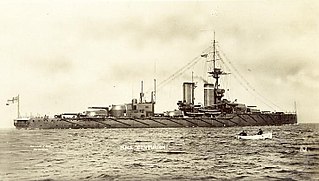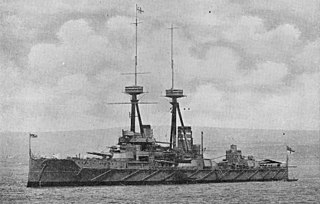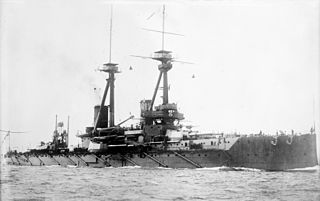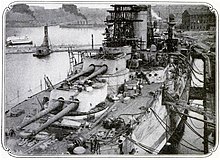
USS Delaware (BB-28) was a dreadnought battleship of the United States Navy, the lead ship of her class. She was laid down at Newport News Shipbuilding in November 1907, launched in January 1909, and completed in April 1910. The sixth ship to be named for the First State, Delaware was armed with a main battery of ten 12-inch (305 mm) guns all on the centerline, making her the most powerful battleship in the world at the time of her construction. She was also the first battleship of the US Navy to be capable of steaming at full speed for 24 continuous hours without suffering a breakdown.

USS Wyoming (BB-32) was the lead ship of her class of dreadnought battleships and was the third ship of the United States Navy named Wyoming, although she was only the second named in honor of the 44th state. Wyoming was laid down at the William Cramp & Sons in Philadelphia in February 1910, was launched in May 1911, and was completed in September 1912. She was armed with a main battery of twelve 12-inch (305 mm) guns and capable of a top speed of 20.5 kn.

USS Arkansas (BB-33) was a dreadnought battleship, the second member of the Wyoming class, built by the United States Navy. She was the third ship of the US Navy named in honor of the 25th state, and was built by the New York Shipbuilding Corporation. She was laid down in January 1910, launched in January 1911, and commissioned into the Navy in September 1912. Arkansas was armed with a main battery of twelve 12-inch (305 mm) guns and capable of a top speed of 20.5 knots.

The Florida-class battleships of the United States Navy comprised two ships: Florida and Utah. Launched in 1910 and 1909 respectively and commissioned in 1911, they were slightly larger than the preceding Delaware class design but were otherwise very similar. This was the first US battleship class in which all ships received steam turbine engines. In the previous Delaware-class, North Dakota received steam turbine propulsion as an experiment while Delaware retained triple-expansion engines.

HMS Royal Sovereign was a Revenge-class battleship of the Royal Navy displacing 29,970 long tons (30,451 t) and armed with eight 15-inch (381 mm) guns in four twin-gun turrets. She was laid down in January 1914 and launched in April 1915; she was completed in May 1916, but was not ready for service in time to participate in the Battle of Jutland at the end of the month. She served with the Grand Fleet for the remainder of the First World War, but did not see action. In the early 1930s, she was assigned to the Mediterranean Fleet and based in Malta.

HMS Iron Duke was a dreadnought battleship of the Royal Navy, the lead ship of her class, named in honour of Arthur Wellesley, 1st Duke of Wellington. She was built by Portsmouth Dockyard, and her keel laid in January 1912. Launched ten months later, she was commissioned into the Home Fleet in March 1914 as the fleet flagship. She was armed with a main battery of ten 13.5-inch (343 mm) guns and was capable of a top speed of 21.25 knots.

HMS Marlborough was an Iron Duke-class battleship of the Royal Navy, named in honour of John Churchill, 1st Duke of Marlborough. She was built at Devonport Royal Dockyard between January 1912 and June 1914, entering service just before the outbreak of the First World War. She was armed with a main battery of ten 13.5-inch (343 mm) guns and was capable of a top speed of 21.25 knots.

HMS Benbow was the third of four Iron Duke-class battleships of the Royal Navy, the third ship to be named in honour of Admiral John Benbow. Ordered in the 1911 building programme, the ship was laid down at the William Beardmore and Company shipyard in May 1912, was launched in November 1913, and was completed in October 1914, shortly after the outbreak of the First World War. The four Iron Dukes were very similar to the preceding King George V class, with an improved secondary battery. She was armed with a main battery of ten 13.5-inch (343 mm) guns and twelve 6 in (152 mm) secondary guns. The ship was capable of a top speed of 21.25 knots, and had a 12-inch (305 mm) thick armoured belt.

HMS Emperor of India was an Iron Duke-class battleship of the British Royal Navy. She was originally to have been named Delhi but was renamed before she was completed, to honour King George V, who was also Emperor of India at the time. The ship was laid down on 31 May 1912 at the Vickers shipyard, and was launched on 27 November 1913. The finished ship was commissioned a year later in November 1914, shortly after the start of the First World War. She was armed with a main battery of ten 13.5-inch (343 mm) guns and was capable of a top speed of 21.25 knots.

HMS Centurion was the second of four King George V-class dreadnought battleships built for the Royal Navy in the early 1910s. She spent the bulk of her career assigned to the Home and Grand Fleets. Aside from participating in the failed attempt to intercept the German ships that had bombarded Scarborough, Hartlepool and Whitby in late 1914, and the Battle of Jutland in May 1916, her service during the First World War generally consisted of routine patrols and training in the North Sea.

HMS St Vincent was the lead ship of her class of three dreadnought battleships built for the Royal Navy in the first decade of the 20th century. After commissioning in 1910, she spent her whole career assigned to the Home and Grand Fleets, often serving as a flagship. Aside from participating in the Battle of Jutland in May 1916, during which she damaged a German battlecruiser, and the inconclusive action of 19 August several months later, her service during World War I generally consisted of routine patrols and training in the North Sea. The ship was deemed obsolete after the war and was reduced to reserve and used as a training ship. St Vincent was sold for scrap in 1921 and broken up the following year.

HMS Bellerophon was the lead ship of her class of three dreadnought battleships built for the Royal Navy in the first decade of the 20th century. She spent her whole career assigned to the Home and Grand Fleets. Aside from participating in the Battle of Jutland in May 1916 and the inconclusive action of 19 August, her service during the First World War generally consisted of routine patrols and training in the North Sea. The ship was deemed obsolete after the war and was used as a training ship before she was placed in reserve. Bellerophon was sold for scrap in 1921 and broken up beginning the following year.

HMS Superb was one of three Bellerophon-class dreadnought battleships built for the Royal Navy in the first decade of the 20th century. She spent almost her whole career assigned to the Home and Grand Fleets. Aside from participating in the Battle of Jutland in May 1916 and the inconclusive action of 19 August, her service during the First World War generally consisted of routine patrols and training in the North Sea.

HMS Temeraire was one of three Bellerophon-class dreadnought battleships built for the Royal Navy in the first decade of the 20th century. She spent almost her whole career assigned to the Home and Grand Fleets. Aside from participating in the Battle of Jutland in May 1916 and the inconclusive action of 19 August, her service during World War I generally consisted of routine patrols and training in the North Sea.

SMS Bayern was the lead ship of the Bayern class of dreadnought battleships in the German Kaiserliche Marine. The vessel was launched in February 1915 and entered service in July 1916, too late to take part in the Battle of Jutland. Her main armament consisted of eight 38 cm (15 in) guns in four turrets, which was a significant improvement over the preceding König's ten 30.5 cm (12 inch) guns. The ship was to have formed the nucleus for a fourth battle squadron in the High Seas Fleet, along with three of her sister ships. Of the other ships only one—Baden—was completed; the other two were canceled later in the war when production requirements shifted to U-boat construction.

HMS Africa was a pre-dreadnought battleship of the Royal Navy, and the penultimate ship of the King Edward VII class. The ship was built by Chatham Dockyard between 1904 and 1906. Armed with a battery of four 12-inch (305 mm) and four 9.2 in (234 mm) guns, she and her sister ships marked a significant advance in offensive power compared to earlier British battleship designs that did not carry the 9.2 in guns. Like all ships of the class, she was named after an important part of the British Empire, namely Africa.

HMS Britannia was a King Edward VII-class pre-dreadnought battleship of the Royal Navy. She was named after Britannia, the Latin name of Great Britain under Roman rule. The ship was built by Portsmouth Dockyard between 1904 and 1906. Armed with a battery of four 12-inch (305 mm) and four 9.2 in (234 mm) guns, she and her sister ships marked a significant advance in offensive power compared to earlier British battleship designs that did not carry the 9.2 in guns.

HMS Erin was a dreadnought battleship of the Royal Navy, originally ordered by the Ottoman government from the British Vickers Company. The ship was to have been named Reşadiye when she entered service with the Ottoman Navy. The Reşadiye class was designed to be at least the equal of any other ship afloat or under construction. When the First World War began in August 1914, Reşadiye was nearly complete and was seized at the orders of Winston Churchill, the First Lord of the Admiralty, to keep her in British hands and prevent her from being used by Germany or German allies. There is no evidence that the seizure played any part in the Ottoman government declaring war on Britain and the Triple Entente.

SMS Königsberg was the lead ship of the Königsberg class of light cruisers, built for the German Kaiserliche Marine during World War I. She took the name of the earlier Königsberg, which had been destroyed during the Battle of Rufiji Delta in 1915. The new ship was laid down in 1914 at the AG Weser shipyard, launched in December 1915, and commissioned into the High Seas Fleet in August 1916. Armed with eight 15 cm SK L/45 guns, the ship had a top speed of 27.5 kn.

United States Battleship Division Nine was a division of four, later five, dreadnought battleships of the United States Navy's Atlantic Fleet that constituted the American contribution to the British Grand Fleet during World War I. Although the U.S. entered the war on 6 April 1917, hesitation among senior officers of the U.S. Navy as to the wisdom of dividing the American battle fleet prevented the immediate dispatch of any capital ships for service in the war zone. Following a direct request from the British Admiralty and a series of high level staff meetings, American opinion changed, and Battleship Division Nine joined the Grand Fleet on 7 December 1917. Within that organization, the Division served as the Sixth Battle Squadron.

























